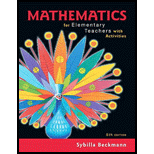
Concept explainers
Suppose that 1% of the population has a certain disease. Also suppose that there is a test for the disease, but it is not completely accurate: It has a 2% rate of false positives and a 1 % rate of false negatives. This means that the test reports that 2% of the people who don’t have the disease do have it, and the test reports that 1% of the people who do have the disease don’t have it. This problem is about the following question:
If a person tests positive for the disease, what is the probability that he or she actually has the disease?
Before you start answering the next set of questions, go back and read the beginning of the problem again. Notice that there is a difference between actually having the disease and testing positive for the disease, and there is a difference between not having the disease and testing negative for it.
a. What do you think the answer to the previous question is? (Answer without performing any calculations—just make a guess.)
b. For parts (b) through (f), suppose there is a random group of 10,000 people and all of them are tested for the disease.
Of the 10,000 people, ¡n the ideal, how many would you expect to actually have the disease and how many would you expect not to have the disease?
c. Continuing part (b), of the people from the group of 10,000 who do not have the disease, how many would you expect to test positive, in the ideal? (Give a number, not a percentage.)
d. Continuing part (b), of the people from the group of 10,000 who have the disease, how many would you expect to test positive? (Give a number, not a percentage.)
e. Using your work in parts (c) and (d), of the people from the group of 10,000, how many in total would you expect to test positive, in the ideal?
f. Using your previous work, what percent of the people who test positive for the disease should actually have the disease, in the ideal? How does this compare to your guess in part (a)? Are you surprised at the actual answer?
Want to see the full answer?
Check out a sample textbook solution
Chapter 16 Solutions
Mathematics For Elementary Teachers With Activities
- 3. Consider the initial value problem 9y" +12y' + 4y = 0, y(0) = a>0: y′(0) = −1. Solve the problem and find the value of a such that the solution of the initial value problem is always positive.arrow_forward5. Euler's equation. Determine the values of a for which all solutions of the equation 5 x²y" + axy' + y = 0 that have the form (A + B log x) x* or Ax¹¹ + Bä” tend to zero as a approaches 0.arrow_forward4. Problem on variable change. The purpose of this problem is to perform an appropriate change of variables in order to reduce the problem to a second-order equation with constant coefficients. ty" + (t² − 1)y'′ + t³y = 0, 0arrow_forwardsolve the system of equationsarrow_forward30% of all college students major in STEM (Science, Technology, Engineering, and Math). If 48 college students are randomly selected, find the probability thata. Exactly 12 of them major in STEM. b. At most 17 of them major in STEM. c. At least 12 of them major in STEM. d. Between 9 and 13 (including 9 and 13) of them major in STEM.arrow_forward7% of all Americans live in poverty. If 40 Americans are randomly selected, find the probability thata. Exactly 4 of them live in poverty. b. At most 1 of them live in poverty. c. At least 1 of them live in poverty. d. Between 2 and 9 (including 2 and 9) of them live in poverty.arrow_forwardarrow_back_iosSEE MORE QUESTIONSarrow_forward_ios
 Holt Mcdougal Larson Pre-algebra: Student Edition...AlgebraISBN:9780547587776Author:HOLT MCDOUGALPublisher:HOLT MCDOUGAL
Holt Mcdougal Larson Pre-algebra: Student Edition...AlgebraISBN:9780547587776Author:HOLT MCDOUGALPublisher:HOLT MCDOUGAL Big Ideas Math A Bridge To Success Algebra 1: Stu...AlgebraISBN:9781680331141Author:HOUGHTON MIFFLIN HARCOURTPublisher:Houghton Mifflin Harcourt
Big Ideas Math A Bridge To Success Algebra 1: Stu...AlgebraISBN:9781680331141Author:HOUGHTON MIFFLIN HARCOURTPublisher:Houghton Mifflin Harcourt Glencoe Algebra 1, Student Edition, 9780079039897...AlgebraISBN:9780079039897Author:CarterPublisher:McGraw Hill
Glencoe Algebra 1, Student Edition, 9780079039897...AlgebraISBN:9780079039897Author:CarterPublisher:McGraw Hill- Algebra & Trigonometry with Analytic GeometryAlgebraISBN:9781133382119Author:SwokowskiPublisher:Cengage



